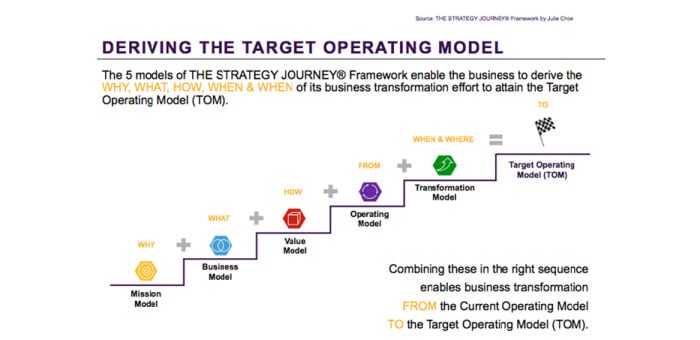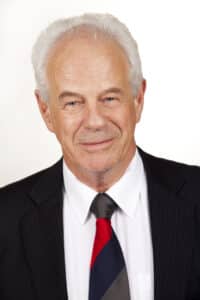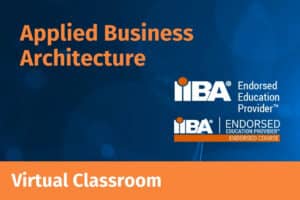The term Target Operating Model (or TOM) has been used a lot in many of the organisations that I have worked for all around the world over the years. Many 100s of millions of dollars in business change budget has been invested in these projects along with many 1000s of people, man hours and resources. Having been involved in numerous initiatives, I’ve seen all manner of possible outcomes. Some have succeeded in delivering very beneficial outcomes for their organisations. Some have failed to deliver anything.
The Operating Model is HOW a business functions; including what capabilities (the processes, data, people and systems) it has to keep itself running; which need to be applied at the right time (WHEN) and in the right place, in different locations (WHERE).
I like to use the car analogy to describe the Operating Model as the engine of an organisation. In 2016, the fastest Formula One (F1) car, the Mercedes Silver Arrow, driven by Lewis Hamilton (arguably the fastest driver), did not win because of engine and reliability problems. Instead the World Championship was won by his teammate Nico Rosberg, who had a better functioning engine. Nico benefited from a slightly better operating model, and that’s what led to his overall title. Nico had the processes, data, systems and the people (including himself) – the complete capability package – to win that World Championship. The mechanical failures that Lewis suffered, mostly not through fault of his own, were a result of failures somewhere within his operating model. It is clear Lewis also had some organisational problems within his management team, and we do not know what other issues lay behind the Mercedes garage or in Lewis’ own mind. Put simply, he lost because his operating model package was inferior to Nico’s.
WHAT IS A TARGET OPERATING MODEL (TOM)?
The Target Operating Model (TOM) is a future state version of the Operating Model at a point in time.
A Target Operating Model doesn’t exist yet, and to achieve it, the Operating Model itself must change, requiring a large transformation effort in the form of a programme of change. However, change itself isn’t good, unless it is for the right reason(s). So, what are these reason(s)?
If the point of the operating model is to execute how the business model needs to function, then as part of any transformational change programme moving towards this new Target Operating Model, it would need to be aligned to changes required in the overall strategy of the business. This would cover any changes to the goals and objectives within its overall Mission and Vision, to its business model, and the new or increased value that the organisation is set to deliver from the changes.
This is why I have described the whole strategy lifecycle as a journey, with the 5 stages of THE STRATEGY JOURNEY and the 5 models of THE STRATEGY JOURNEY Framework. A business enterprise is a living entity that is constantly changing on its journey.
The Target Operating Model is simply a viewpoint of what that enterprise wants to change into; as it covers what all 5 models will look like at a time in the future.

The Operating Model is HOW a business functions; including what capabilities (the processes, data, people and systems) it has to keep itself running; which need to be applied at the right time (WHEN) and in the right place, in different locations (WHERE).
I like to use the car analogy to describe the Operating Model as the engine of an organisation. In 2016, the fastest Formula One (F1) car, the Mercedes Silver Arrow, driven by Lewis Hamilton (arguably the fastest driver), did not win because of engine and reliability problems. Instead the World Championship was won by his teammate Nico Rosberg, who had a better functioning engine. Nico benefited from a slightly better operating model, and that’s what led to his overall title. Nico had the processes, data, systems and the people (including himself) – the complete capability package – to win that World Championship. The mechanical failures that Lewis suffered, mostly not through fault of his own, were a result of failures somewhere within his operating model. It is clear Lewis also had some organisational problems within his management team, and we do not know what other issues lay behind the Mercedes garage or in Lewis’ own mind. Put simply, he lost because his operating model package was inferior to Nico’s.
WHAT IS A TARGET OPERATING MODEL (TOM)?
The Target Operating Model (TOM) is a future state version of the Operating Model at a point in time.
A Target Operating Model doesn’t exist yet, and to achieve it, the Operating Model itself must change, requiring a large transformation effort in the form of a programme of change. However, change itself isn’t good, unless it is for the right reason(s). So, what are these reason(s)?
If the point of the operating model is to execute how the business model needs to function, then as part of any transformational change programme moving towards this new Target Operating Model, it would need to be aligned to changes required in the overall strategy of the business. This would cover any changes to the goals and objectives within its overall Mission and Vision, to its business model, and the new or increased value that the organisation is set to deliver from the changes.
This is why I have described the whole strategy lifecycle as a journey, with the 5 stages of THE STRATEGY JOURNEY and the 5 models of THE STRATEGY JOURNEY Framework. A business enterprise is a living entity that is constantly changing on its journey.
The Target Operating Model is simply a viewpoint of what that enterprise wants to change into; as it covers what all 5 models will look like at a time in the future.

In my next article, I will take a look at some of the different types of Target Operating Models and how you can adapt your Target Operating Model initiatives accordingly based on the type of organisation you are working with.
Blog Article by Julie Choo; subject matter expert, industry specialist and Applied Operating Model Design course designer and instructor.
Our Applied Operating Model Design is a 4 day practical workshop that teaches you how to design a Target Operating Model along with a transition plan that you can use to lead and drive business change in an organisation. The goal is to empower participants by providing them with the frameworks and skills to achieve measurable and sustainable results in delivering operating model transformation.










































































